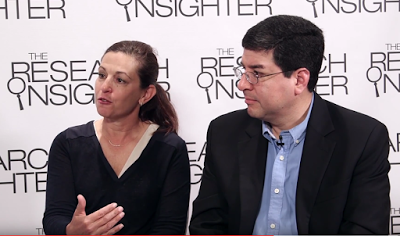Conference event
Partnering With Data Scientists: How Market Researchers Make the Most of Big Data At LinkedIn

An interview
with Sally Sadosky, Group Manager in Marketing Research, and Al Nevarez, Senior
Manager in Business Analytics, from LinkedIn
with Sally Sadosky, Group Manager in Marketing Research, and Al Nevarez, Senior
Manager in Business Analytics, from LinkedIn
The introduction and evolution of big data
has opened up a whole world of new opportunities for market researchers.
However, it has also brought with it a set of challenges, not least around the
skills gap traditional market research teams are facing.
has opened up a whole world of new opportunities for market researchers.
However, it has also brought with it a set of challenges, not least around the
skills gap traditional market research teams are facing.
With 400 million members, maximizing this
wealth of data is more pressing for LinkedIn than most. We
spoke to Sally Sadosky, Group Manager in Marketing Research, and Al Nevarez,
Senior Manager in Business Analytics, from the social media giant about how
internal partnerships between departments has helped them gain invaluable
insights from their data.
wealth of data is more pressing for LinkedIn than most. We
spoke to Sally Sadosky, Group Manager in Marketing Research, and Al Nevarez,
Senior Manager in Business Analytics, from the social media giant about how
internal partnerships between departments has helped them gain invaluable
insights from their data.
How
has market research changed with big data?
has market research changed with big data?
SS: 'There's been lot of changes and all
for the positive. At LinkedIn because we are able to look at the behavior of
the members, we are able to do a lot more research in advance ' looking at
behaviors, looking at trends, testing hypotheses. When we actually talk to
members, either through quantitative surveys or qualitative methods, we can
really focus our questions.
for the positive. At LinkedIn because we are able to look at the behavior of
the members, we are able to do a lot more research in advance ' looking at
behaviors, looking at trends, testing hypotheses. When we actually talk to
members, either through quantitative surveys or qualitative methods, we can
really focus our questions.
We have already fully analysed what we know
to be facts, so we don't have to spend time asking them what they do, now we
can spend all our time on the 'whys'. Our surveys tend to be a lot shorter,
which is great for response rates and completion rates. Our in depth interviews
tend to be a lot more focused as well, as we can say 'we noticed you do this,
tell us why.'
to be facts, so we don't have to spend time asking them what they do, now we
can spend all our time on the 'whys'. Our surveys tend to be a lot shorter,
which is great for response rates and completion rates. Our in depth interviews
tend to be a lot more focused as well, as we can say 'we noticed you do this,
tell us why.'
What
skills does a market research team need to take advantage of the big data
opportunity?
skills does a market research team need to take advantage of the big data
opportunity?
AN: 'It starts with a healthy, inquisitive,
imaginative mind. We like to look at this Venn diagram of skills that refers to
software skills, maths skills and business skills. We look for folks that have
all three. If you only have two of those it is dangerous; if you're the hacker
with the business but don't know the math and statistics, you can come to
erroneous conclusions.
imaginative mind. We like to look at this Venn diagram of skills that refers to
software skills, maths skills and business skills. We look for folks that have
all three. If you only have two of those it is dangerous; if you're the hacker
with the business but don't know the math and statistics, you can come to
erroneous conclusions.
At the end of the day, it's about being
comfortable with all kinds of data ' we have 400 million members on LinkedIn
which is a lot of data. But we don't collect 400 million survey records ' that
data is smaller. It's about being creative and understanding the technology
well enough that you can bring the little data and the big data together to
help make big decisions.'
comfortable with all kinds of data ' we have 400 million members on LinkedIn
which is a lot of data. But we don't collect 400 million survey records ' that
data is smaller. It's about being creative and understanding the technology
well enough that you can bring the little data and the big data together to
help make big decisions.'
What
tips do you have for other market researchers interested in collaborating with the
big data aspects of their organization?
tips do you have for other market researchers interested in collaborating with the
big data aspects of their organization?
SS: 'It's a little bit of a scavenger hunt
in the beginning because the data scientists are scattered throughout the
company and they don't report in to marketing where I sit. You have to create
those relationships. I focus on small wins. We are jointly storytelling and
that gets people asking for more, so I can go back and ask for dedicated
resource, hire more people or ask for 20 hours rather than 5 hours.
in the beginning because the data scientists are scattered throughout the
company and they don't report in to marketing where I sit. You have to create
those relationships. I focus on small wins. We are jointly storytelling and
that gets people asking for more, so I can go back and ask for dedicated
resource, hire more people or ask for 20 hours rather than 5 hours.
It has to be a very proactive thing as in
many companies they are still considered very separate disciplines with very
separate approaches. We think about the same thing; we think about member
empathy and telling the story of our members, and now we have a lot of facts
and a lot of opinions and we are able to put those together in a seamless way
which tells really good member stories. It's being proactive and being
persistent in getting those small wins.'
many companies they are still considered very separate disciplines with very
separate approaches. We think about the same thing; we think about member
empathy and telling the story of our members, and now we have a lot of facts
and a lot of opinions and we are able to put those together in a seamless way
which tells really good member stories. It's being proactive and being
persistent in getting those small wins.'
AN: 'If you're thinking about a data science
team, think about how that team can really drive the bottom line for the
company and then that will help that team thrive and grow and therefore be able
to support all these other organizations.'
team, think about how that team can really drive the bottom line for the
company and then that will help that team thrive and grow and therefore be able
to support all these other organizations.'
Watch
the full interview below:
the full interview below:

